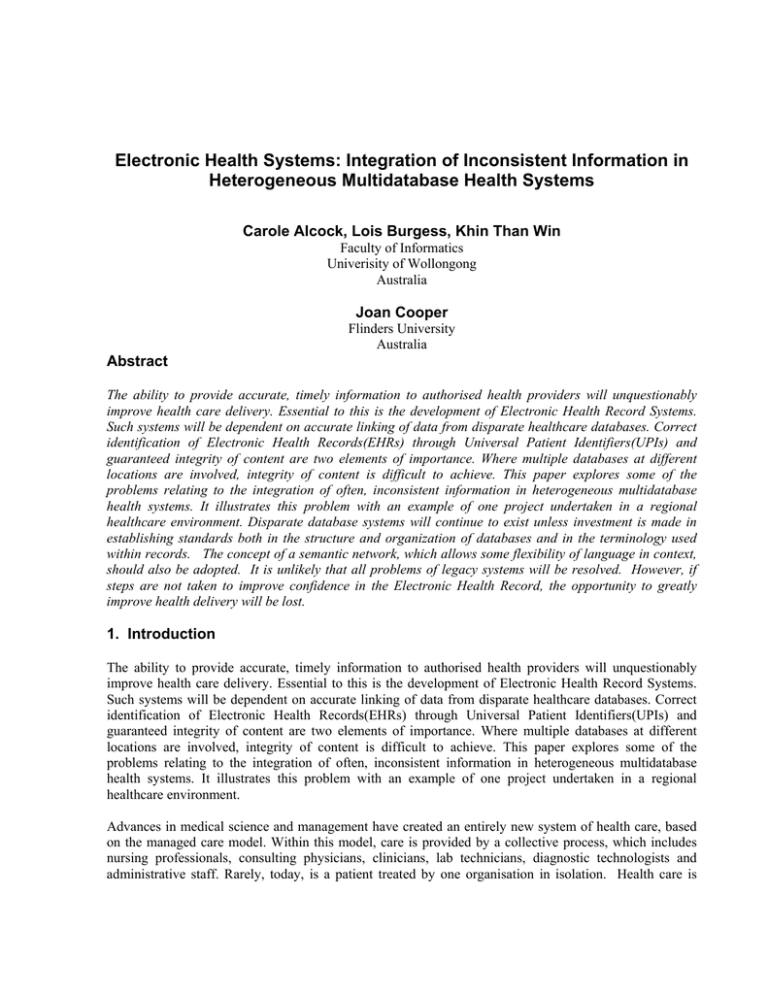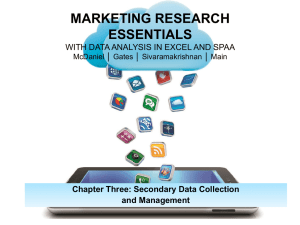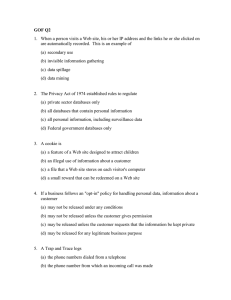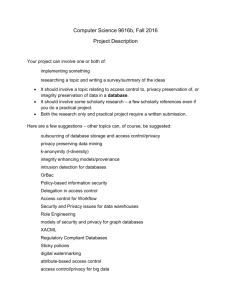Electronic Health Systems: Integration of Inconsistent Information in
advertisement

Electronic Health Systems: Integration of Inconsistent Information in Heterogeneous Multidatabase Health Systems Carole Alcock, Lois Burgess, Khin Than Win Faculty of Informatics Univerisity of Wollongong Australia Joan Cooper Flinders University Australia Abstract The ability to provide accurate, timely information to authorised health providers will unquestionably improve health care delivery. Essential to this is the development of Electronic Health Record Systems. Such systems will be dependent on accurate linking of data from disparate healthcare databases. Correct identification of Electronic Health Records(EHRs) through Universal Patient Identifiers(UPIs) and guaranteed integrity of content are two elements of importance. Where multiple databases at different locations are involved, integrity of content is difficult to achieve. This paper explores some of the problems relating to the integration of often, inconsistent information in heterogeneous multidatabase health systems. It illustrates this problem with an example of one project undertaken in a regional healthcare environment. Disparate database systems will continue to exist unless investment is made in establishing standards both in the structure and organization of databases and in the terminology used within records. The concept of a semantic network, which allows some flexibility of language in context, should also be adopted. It is unlikely that all problems of legacy systems will be resolved. However, if steps are not taken to improve confidence in the Electronic Health Record, the opportunity to greatly improve health delivery will be lost. 1. Introduction The ability to provide accurate, timely information to authorised health providers will unquestionably improve health care delivery. Essential to this is the development of Electronic Health Record Systems. Such systems will be dependent on accurate linking of data from disparate healthcare databases. Correct identification of Electronic Health Records(EHRs) through Universal Patient Identifiers(UPIs) and guaranteed integrity of content are two elements of importance. Where multiple databases at different locations are involved, integrity of content is difficult to achieve. This paper explores some of the problems relating to the integration of often, inconsistent information in heterogeneous multidatabase health systems. It illustrates this problem with an example of one project undertaken in a regional healthcare environment. Advances in medical science and management have created an entirely new system of health care, based on the managed care model. Within this model, care is provided by a collective process, which includes nursing professionals, consulting physicians, clinicians, lab technicians, diagnostic technologists and administrative staff. Rarely, today, is a patient treated by one organisation in isolation. Health care is ‘wholistic’ in approach encompassing many health care organisations both public and private. There are many vital activities in this new health care environment, encompassing areas such as the delivery of institutional care, health administration, information management and community care activities. All depend on correct identification of patients (Appavu, 1994). It has become imperative to uniquely identify patients across multiple providers and to be able to access patient information from multiple locations in order to support continuity of care. Electronic Health Records (EHRs) and associated Unique Patient Identifiers (UPIs) are already a feature of the health system in both public and private health sectors and their use is increasing. The stated objective of the introduction and use of EHRs and UPIs is better health outcomes. In an Australian report published in 2000, the following benefits were highlighted: Improve health outcomes by increasing opportunities for co-ordinated and continuous care within the health care system; Provide health providers with access to a more comprehensive patient history, and therefore improve clinical decision making; Allow consumers to access their own records; Be used as a tool for sharing information between health providers and consumers; Reduce the reliance on the patients own memory to provide medical history; Reduce possible errors in information transfer, and therefore preventable adverse events; Reduce duplication of diagnostic testing and imaging, and hence reduce costs; Improve accountability for health care decision making by making available a better quality of data; Make more data accessible for research purposes; Bring together fragmented and dispersed information about an individual to a single accessible point; Track the use of critical implantable medical devices; Improve communication between practitioners and people with disabilities by providing a continuous medical record, particularly where the person has difficulty communicating or where the person has little family support. (Panacea or Placebo: Linked Electronic Health Records and Improvement in Health Outcomes, Report to the NSW Minister for Health, December, 2000). While potential benefits are clear, many problems must be addressed before these can be achieved. 2. Problems with existing medical records Currently, health records in Australia consist of a mix of electronic and paper-based systems – often maintained in discrete locations eg. Stand alone computer or health practitioners file. In some cases patients may take records with them especially when moving interstate, but most often, they remain property of health provider. Even within the one State there may be difficulties in easily sharing records. The four NSW Area Health Services have developed a UPI systems but have set up different systems. However, they are llooking at linking individual records across health providers within their area. An example is Central Sydney Health Service’s Clinical Information System (CIS) which provides clinicians with a comprehensive view of patients’ visit history and some medical test/ procedure results. In the future, this will be extended to a full electronic record, replacing all paper-based medical histories. Area Health Systems are to be supported by a statewide linkage mechanism by the end of 2002. A Privacy and Health Background Paper from the NSW Ministerial Advisory Committee (Aug 2000) listed the following issues for concern: Current Health Systems – •the number of legacy health system •incompatibility problems – problems with transfer of data and providing a complete/accurate medical history •inconsistency of standards for coding and classifying patient/clinical info Limitations of Existing Systems •Problems outlined above limit the possibility of developing a viable system based on EHR •No single existing record that contains a complete patient history •No computerised links to network GPs, hospitals, community health and specialist service providers •Problem with transfer of discharge info from hosp to GP/Community health providers •Problem with linking of systems within hospitals let alone outside health environ (eg. Between A&E and Intensive care to a ward within the hospital •No single identifier to enable health providers to identify with certainty a patient 3.Proposals for reform •Both NSW State and Commonwealth Governments are to work together on EHR development and implementation •Improve links among all health professionals within and across hospitals and with other health professionals •Establish UPI for every individual in NSW irrespective of at what point they have entered the health system Proposed Features of EHR •Accessible to individual consumer and provider independent of location incorporating privacy and security safeguards •Individual consent for inclusion/transfer in info amongst providers •Records to contain clinical records, advice, specialist referrals, pharmacy details, diagnostic tests and results •Provide all health providers with info about patient med history with patient consent •Assist in clinical decision making •Enable collection of data for use in medical research, measure quality and performance of health care provision, give consumer better health choices. However, underlying the effective development of an HER is the problem of heterogenous /disparate databases including legacy systems. 4. Database inconsistencies Getta (2001) Integration of inconsistent information in heterogeneous multidatabase systems: The trend towards globalisation of information systems requires seamless integration of many independent sources of information (Sheth & Larson, 1990; Tsai & Chen, 1993; Tseng & Wang, 1993a). A concept of multidatabase systems has been introduced some time ago to provide the architectural backgrounds for the systems that integrate a large number of local and independent database systems into a single global database system. Strong autonomy of the local database systems and the delays caused by the wide-area networks make preservation of data consistency in multidatabase systems too time consuming. This is why the global consistency is frequently sacrificed in order to preserve the autonomy of local systems and to speed up processing of distributed transactions. It is inevitable that at some point in time integration of the local databases may provide inconsistent results. Multidatabase systems belong to a category of global information services where data inconsistencies are a common problem. A typical environment where we have to deal with different representations of the same data objects and/or association is a group of autonomous medical database systems recording information related to patients and their health records. Frequent migration of patients from area to area causes multiple registrations of the same patients in different database systems. A high level of autonomy of the local systems and lack of global control contributes to construction of similar and not identical descriptions of the same patients in different databases. Other researchers who make similar claims to the above are (Garcia-Solaco, Saltor and Castellanos, 1995; Agarwal, Keller, Wiederhold & Saraswat, 1995; Reddy & Gupta, 1994; Lim, Srivastava & Shekhar, 1994). 5. Data linking Problems arise in any attempt to link health records across disparate database systems. This was evident in a recent project, which focused on maternal and infant health records of the South West Sydney Area Health Services and the development of software to link disparate legacy health databases within the Maternal and Infant Network (MINET). MINET is a long term research project studying longitudinal health data of over 60,000 mothers and babies in the South West Sydney Area Health Service Division conducted through the Simpson Centre for Health Service Innovation. The Centre has vast amounts of data from Hospitals, Community and General Practices. Its primary role is in health care research. The study aims to provide vital information on health services in order to improve decision making as to the types of health provision required throughout the region and to aid in the development of health policy. While there is an immediate demand for the integration of the legacy databases, the long term plan has been to make available at the different health care centres, records of mothers and their children which will allow for fully informed decision making when it comes to health care provision. Effective linkage of data from different data sources is essential if appropriate comparison of data is to be achieved. 6. The MINET / LinkIT project The MINET data involved are from hospitals, clinics and well-baby centres. To capture all health information of the mother and infant, integration of databases is needed. Data items are linked accordingly with the LinkIT software developed by the team at the University of Wollongong. The system does not conflict with the existing systems and does not disrupt current workflow. It amalgamates well with the ongoing processes. The software acts as an engine with translation and linking processes. The translation process conducts the necessary data mining for selecting the data source and the linking process matches and links the data. Currently, data integration is based on the matching of source data in text format. As there were security and privacy concerns, the development team used the dummy data during the development, with ‘real life’ data testing being done at the Simpson Centre with an appropriately authorised person. As the patients are not uniquely identified, the data matching and linking are based on the Medical Record Number (MRN) and a number of attributes which include: Mother’s Community Medical Record Number (MCMRN), Baby’s Community Medical Record Number (BCMRN), Mother’s Hospital Medical Record Number (MHMRN), Baby’s Hospital Medical Record Number (BHMRN) and attributes such as Mother’s date of birth, visit date, admit date, discharge date and baby’s date of birth. Matching of the data presents a challenge because the one individual may have several identifiers of the same type in different databases. This is particularly a problem for women whose marital status and name may vary and also for children within ‘blended’ families. This highlights the fact that unique identifiers are of utmost importance in the linking of databases. Data integrity is of concern because health care providers and researchers need to decide whether the records with other possible matches are for the same individuals’ records or of different individuals. As well, because of errors in data entry or transcription, there may be more than one person with the same medical record number. Clearly, if the data integrity cannot be guaranteed, the result will have an impact on treatment, decision making, statistical analysis and the measurement of health outcomes. As the linking system involved disparate legacy databases with different data attributes, work on this project has been a challenge. The LinkIT Software aims to link records in timely manner with precision and accuracy. Privacy and security can be maintained as in paper based record systems. Proper authorisation and authentication of the user for data editing is required and any amendment made will be logged in the audit trail. However, further work is needed on the system. Experience with this project has emphasised the problems which arise because of difficulties in establishing a unique identifier for individuals, especially when this is complicated by changing family situations of participants as is the case in the South West Sydney region. 7. Approaches elsewhere Van Wingerde, et al (1996) describes the W3-EMRS architecture which was designed to access clinical data at the Children’s Hospital, Boston. The demonstration project provided access over the web to a single EMRS database from which all identifiable data had been removed, but multiple database access was an objective. The desirability of web access is clear although reservations might be expressed from a security perspective. The W3 EMRS Project paper on multiplatform Internet access, emphasises the need for a collaborative approach to the implementation and deployment of an Electronic Medical Record System (EMRS). Objectives of this project focus on standards. Among the issues raised are the need for the establishment of ‘a canonical electronic medical record structure with supporting data abstraction processes to provide consistent views of medical information independent of underlying database structure’ and the employment of ‘standardised medical vocabularies in the EMRS’ and the provision for ‘translating / mapping of local non-standardised medical vocabularies.’ Discussion on standards has been an important focus of a the research into an ERMS. An important issue is that of varying vocabulary and medical terminology. Variability of terminology complicates retrieval. The National Library of Medicine is attempting to address the problem with it’s development of the Unified Medical Language system (ULMS). A’Metathesaurus’ has been developed to address the problem of multiple medical vocabularies. This consists of a database of information relating to medical terminology. A UMLS semantic network is another aspect of this project. This, it was believed would allow for greater flexibility and be a basis for achieving the objective stated above: relating to the employment of ‘standardised medical vocabularies in the EMRS’ and the provision for ‘translating / mapping of local non-standardised medical vocabularies.’ It has been noted that substantial effort is required in “gluing” a new interface to an existing database. The problem is compounded when multiple databases are involved, some at distant sites. The particular difficulties for remote users need to be considered. Intensive care was another area where the integration of heterogeneous data sources was complex but would be advantageous. Knowledge gaps where retrieval procedures and terminology are concerned may cause problems. 8. Conclusion Concerns over privacy and integrity of the Electronic Health Record will continue to be raised and need to be addressed at both the technical and legislative levels. If the benefits of the EHR are to be achieved, however, much more attention will need to be paid to the problems of data linking. Disparate database systems will continue to exist unless investment is made in establishing standards both in the structure and organization of databases and in the terminology used within records. The proposals outlined in the W3 – EMRS project in the US are positive steps in this direction. The concept of a semantic network, which allows some flexibility of language in context, should also be adopted. It is unlikely that all problems of legacy systems as were seen in the LinkIT project outlined above, will be resolved. However, if steps are not taken to improve public and healthcare confidence in the Electronic Health Record, the opportunity to greatly improve health delivery will be lost. References Appavu, S. (1994) Analysis of Unique Patient Identifier Options, Final Report, U.S. Department of Health and Human Services, November, 1994. Agarwal, S., Keller, A., Wiederhold, G., Saraswat, K (1995) “flexible Relation: An Approach for Integrating Data from Multiple, Possibly Inconsistent Databases” IEEE Data Engineering Conference, Taipei. Australian Medical Association (2001). Comments on proposed privacy Amendment (Private Sector) Bill (2000), Australian Medical Association, http://www.domino.ama.com.au/dir0103/ accessed 24 May 2001 Breitfeld, Philip P. et al. (2001) Accurate case finding using linked electronic clinical and administrative data at a children’s hospital. In: Journal of Clinical Epidemiology. 54:1037-1045. Carter, Meredith (1998). Should patients have access to their medical records? In: Medical Journal of Australia. 169: 596-597. http://www.mja.com.au/public/issues/xmas98/cater/carter.html Coalition for Health Information Policy(2001). Standards for privacy of individually identifiable health information: A brief summary of the final rule. www.amaia.org/resource/policy/chip/final_rule_summary.html accessed March 2001 Commonwealth of Australia, Attorney General’s Department (2000). National Privacy Principles (2000), , http://law.gov.au/privacy/royalnpp.pdf accessed 21 May 2001 Crompton M. (2000). Enhancing privacy and confidentiality in the world of e-health, Proceedings from the National Health Online Summit, Adelaide, August 2000, pp 35-37. http://www.health.gov.au/healthonline/summit/summit.pdf accessed 25 May 2001 Davies, S (1996) Monitor: Extinguishing Privacy on the Information Superhighway, Pan McMillan Australia, Sydney Draft Health Privacy Guidelines (2001), The consultation document issued by the office of the federal privacy commissioner, Sydney, NSW http://www.privacy.gov.au/rfc/index.html accessed 21 May 2001 Eysenbach G. (2000). Consumer health informatics, The British Medical Journal, vol. 320, pp 1713- 1716 Garcia-Solaco, M, Saltor, F, Castellanos, M (1995) “A Structure Based Schema Integration Methodology” IEEE Data Engineering Conference, Taipei. Getta, J (2001 “Integration of inconsistent information in heterogeneous multidatabase systems” World Multiconference on Systems Cybernetics and Informatics, July 2001, Orlando, Florida. Kohane, Isaac S. et al (1996). Sharing Electronic Medical Records across multiple heterogeneous and competing institutions. 1996 AMIA Paper. Proc. AMIA Annual Fall Symposium 1996:608-12. Knoppers B.M. (2000), Confidentiality of Health Information: International Comparative Approaches, A Health Information Network for Australia. Lim, E.P., Srivastava, J., Shekhar,, S (1994). “Resolving Attribute Incompatibility in Database Integration: An Evidential Reasoning Approach” ECDE, 1999 pp. 154-163. Mandl K.D., Szolovits P., Kohane I.S. (2001). Public standards and patients’ control: how to keep electronic medical records accessible but private, vol. 322, pp 283-287 Morris, M., Cooper, J., Bomba, D., Brankovic, L., Miller, M. & Pacheco, F. (1995). Australian HealthCare: a smart card for a clever country. International Journal of Bio-Medical Computing, 40, pp. 101-105. New South Wales Government(2000). Health Records and Improvements in health Outcomes", December. New South Wales Government. New South Wales Government (2000). Health: The Way. Forward NSW Government’s Action Plan for Health – Bulletin no. 1. NSW Health Council (2000). A Better Health System for NSW. Report of the NSW Health Council. NSW Government. NSW Minister for Health. NSW Government (2000). A Frame work for Change. Report to the NSW Minister for Health. NSW Government. NSW Ministerial Advisory Committee on Privacy and Health Information (2000). Panacea or Placebo: Linked Electronic Health Records and Improvement in Health Outcomes, Report to the NSW Minister for Health, December, 2000). Putting Patients First (1999), Comments on Bill C-6, submitted to the senate standing committee on Social Affairs, Science and Technology http://www.cma.ca/advocacy/political/1999/11-29/index.html accessed 23 May 2001 Reddy, M.P., Prasad, B.E., Gupta, A (1994). “A Methodology for Integration of Heterogeneous Databases.” IEEE Track on Knowledge and Data Engineering, December: 920-933. Schoenberg R., Safran C. (2000), Internet based repository of medical records that retains patient confidentiality, British Medical Journal, vol. 321, pp 1199-1203 Sheth, A., Larson, J (1990) “Federated Database Systems for Managing Distributed, Heterogeneous and Autonomous Data bases”, ACM Computing Surveys, 22(1): 183-236. Smith, E (1989). The Australia Card. The Story of its Defeat, MacMillian, Melbourne. Tsai, P.S.M., Chen, A.L.P (1993). “Querying Uncertain Data in Heterogeneous Databases” Proceedings of the IEEE International Workshop on Research Issues in Data Engineering (RIDE) Vienna. Tsang, F.S.E., Chen, A.L.P., Yang, W.P (1993a) “Answering Heterogeneous Database Queries with Degrees of Uncertainty” Distributed and Parallel Databases: An International Journal, 1(3):281-302. Van Wingerde, F.J. et al. (1997). Client-side gathering, processing and display of multi-institutional medical data. Abstracts AMIA Annual Spring 1997:67. Van Wingerde, F.J. et al. (1996). Using HL7 and the world Wide Web for unifying patient data from remote databases. 1996 AMIA Paper. Proc. AMIA Annual Fall Symposium 1996:643-7. W3 EMRS Project. (1994?, 2001). Multiplatform Internet access to multimedia EMRS: excerpts from the original collaborative proposal to the National Library of Medicine funded as grant number U01 LM05877-01.




